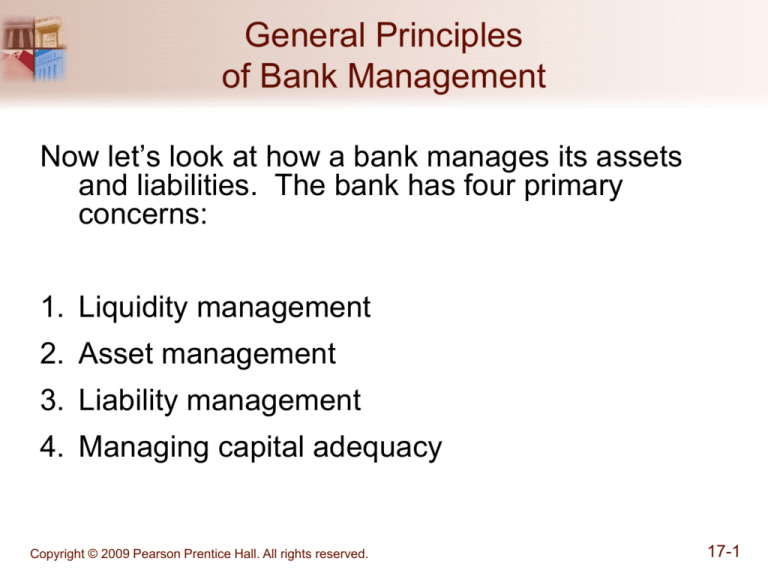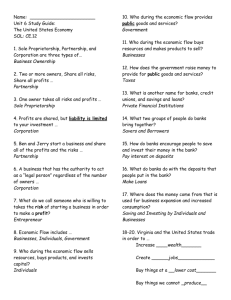
General Principles
of Bank Management
Now let’s look at how a bank manages its assets
and liabilities. The bank has four primary
concerns:
1. Liquidity management
2. Asset management
3. Liability management
4. Managing capital adequacy
Copyright © 2009 Pearson Prentice Hall. All rights reserved.
17-1
Asset Management
• Asset Management: the attempt to earn the
highest possible return on assets while
minimizing the risk.
1. Get borrowers with low default risk, paying
high interest rates
2. Buy securities with high return, low risk
…Diversify (banks must attempt to lower risk by
diversifying): not “put too many eggs in one
basket”
Copyright © 2009 Pearson Prentice Hall. All rights reserved.
17-2
Liability Management
• Liability Management: managing the
source of funds, from deposits, to CDs,
to other debt.
1. Markets for making overnight loans between
banks to meet reserve needs
2. When see loan opportunities, borrow or issue
securities to acquire funds
3. Costs vs. stability
4. Reduced borrowings: credit crunch
Copyright © 2009 Pearson Prentice Hall. All rights reserved.
17-3
Liability Management
• It’s important to understand that banks now
manage both sides of the balance sheet
together, whereas it was more separate in
the past. Indeed, most banks now manage
this via the asset-liability management
(ALM) committee.
Copyright © 2009 Pearson Prentice Hall. All rights reserved.
17-4
Capital Adequacy Management
1. Bank capital is a cushion that prevents bank failure.
For example, consider these two banks:
High Capital Bank
Assets
Reserves
Loans
Liabilities
$10 million Deposits
$90 million Bank Capital
$90 million
$10 million
Low Capital Bank
Assets
Reserves
Loans
Liabilities
$10 million Deposits
$90 million Bank Capital
Copyright © 2009 Pearson Prentice Hall. All rights reserved.
$96 million
$4 million
17-5
Capital Adequacy Management
What happens if these banks make loans
or invest in securities (say, subprime
mortgage loans, for example) that end up
losing money? Let’s assume both banks
lose $5 million from bad loans.
Copyright © 2009 Pearson Prentice Hall. All rights reserved.
17-6
Capital Adequacy Management
Impact of $5 million loan loss
High Capital Bank
Assets
Reserves
Loans
Liabilities
$10 million Deposits
$85 million Bank Capital
$90 million
$5 million
Low Capital Bank
Assets
Reserves
Loans
Liabilities
$10 million Deposits
$85 million Bank Capital
$96 million
-$1 million
Conclusion: A bank maintains reserves to lessen the
chance that it will become insolvent.
Copyright © 2009 Pearson Prentice Hall. All rights reserved.
17-7
Capital Adequacy Management
So, why don’t banks want to hold a lot of
capital??
2. Higher is bank capital, lower is return on equity
(the net profit after taxes per dollar of equity
capital)
–
ROE = Net Profits/Equity Capital
–
Capital , ROE
Copyright © 2009 Pearson Prentice Hall. All rights reserved.
17-8
Capital Adequacy Management
3. Trade-off between safety (high capital) and
ROE
4. Banks also hold capital to meet capital
requirements: if bank managers want to
hold less bank capital relative to assets
than is required by the regulatory
authorities, the amount of bank capital is
determined by the bank capital
requirements
Copyright © 2009 Pearson Prentice Hall. All rights reserved.
17-9
Measuring Bank Performance
• Ratio analysis is useful to measure
performance and compare performance
among banks.
• In order to measure ratios, we need to
reclassify the bank’s balance sheet
Copyright © 2009 Pearson Prentice Hall. All rights reserved.
17-10
Measuring Bank Performance
Assets
Liabilities
Interest-earning assets
Interest-costing liabilities
Non interest-earning assets
Non interest-costing liabilities
Real estate assets
Bank capital
Total assets
Total liabilities
• Working capital = interest earning assets –
interest costing liabilities
Copyright © 2009 Pearson Prentice Hall. All rights reserved.
17-11
Measuring Bank Performance
Much like any business, measuring bank
performance requires a look at the income
statement.
For banks, this is different from, say, a
manufacturing firm’s income statement.
Copyright © 2009 Pearson Prentice Hall. All rights reserved.
17-12
Income statement
INCOME STATEMENT
Interest income
- interest expenses
= Net Interest profits
+ Noninterest income (fees and gains/losses on securities)
= Profits from Intermediation
- Operating costs
= Net operating profits
+/- Extraordinary items
- Income taxes
= Net profits (Profits after taxes)
Copyright © 2009 Pearson Prentice Hall. All rights reserved.
17-13
Measuring Bank Performance
• ROE = Net Profits/ Equity Capital
• Operating ROE = Net Operating Profits /
Equity Capital
• Operating ROE = NOP/EC =
NIP/EC * PI/NIP * NOP/PI
Copyright © 2009 Pearson Prentice Hall. All rights reserved.
17-14
Measuring Bank Performance
• Interest ROE = NIP/EC
• NIP/EC = (Interest income / Interestearning assets) * (Working capital / EC) +
(Interest income / Interest-earning assets –
Interest expenses / Interest-costing
liabilities) * (Interest-costing liabilities/EC)
Copyright © 2009 Pearson Prentice Hall. All rights reserved.
17-15









